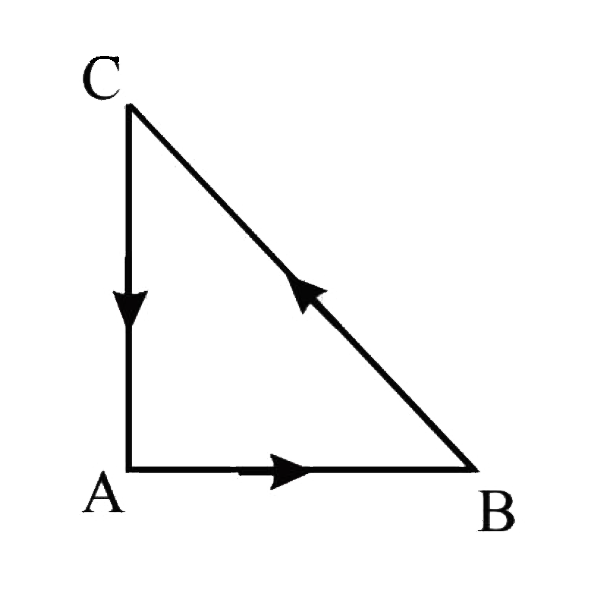Two force in the ratio act simultaneously on a particle. The resultant of these forces is three times the first force. The angle between them is
The correct Answer is:A
To solve the problem, we need to determine the angle between two forces acting on a particle, given that their magnitudes are in the ratio 1:2 and the resultant force is three times the magnitude of the first force.
1. Define the Forces:
Let the magnitude of the first force F1 be F. Since the forces are in the ratio 1:2, the magnitude of the second force F2 will be 2F.
2. Define the Resultant Force:
According to the problem, the resultant force R is three times the first force. Therefore, we can write:
R=3F
3. Use the Formula for Resultant of Two Forces:
The formula for the resultant R of two forces F1 and F2 acting at an angle θ is given by:
R=√F21+F22+2F1F2cosθ
Substituting the values of F1 and F2:
R=√F2+(2F)2+2⋅F⋅2F⋅cosθ
Simplifying this, we get:
R=√F2+4F2+4F2cosθ
R=√5F2+4F2cosθ
4. Set the Resultant Equal to Three Times the First Force:
Since R=3F, we can set up the equation:
3F=√5F2+4F2cosθ
5. Square Both Sides:
Squaring both sides to eliminate the square root gives:
(3F)2=5F2+4F2cosθ
9F2=5F2+4F2cosθ
6. Rearrange the Equation:
Rearranging the equation, we find:
9F2−5F2=4F2cosθ
4F2=4F2cosθ
7. Divide by 4F2:
Dividing both sides by 4F2 (assuming F≠0):
1=cosθ
8. Find the Angle:
The cosine of an angle is equal to 1 when the angle θ is:
θ=0∘
Conclusion:
The angle between the two forces is 0∘.
Let the magnitude of the first force F1 be F. Since the forces are in the ratio 1:2, the magnitude of the second force F2 will be 2F.
According to the problem, the resultant force R is three times the first force. Therefore, we can write:
R=3F
The formula for the resultant R of two forces F1 and F2 acting at an angle θ is given by:
R=√F21+F22+2F1F2cosθ
Substituting the values of F1 and F2:
R=√F2+(2F)2+2⋅F⋅2F⋅cosθ
Simplifying this, we get:
R=√F2+4F2+4F2cosθ
R=√5F2+4F2cosθ
Since R=3F, we can set up the equation:
3F=√5F2+4F2cosθ
Squaring both sides to eliminate the square root gives:
(3F)2=5F2+4F2cosθ
9F2=5F2+4F2cosθ
Rearranging the equation, we find:
9F2−5F2=4F2cosθ
4F2=4F2cosθ
Dividing both sides by 4F2 (assuming F≠0):
1=cosθ
The cosine of an angle is equal to 1 when the angle θ is:
θ=0∘
The angle between the two forces is 0∘.
Topper's Solved these Questions
- LAWS OF MOTION Book:VMC MODULES ENGLISHChapter:LAWS OF MOTION Exercise:EFFICIENT
Explore 50 Videos
- KINEMATICS OF A PARTICLE Book:VMC MODULES ENGLISHChapter:KINEMATICS OF A PARTICLE Exercise:JEE Advanced (archive)
Explore 14 Videos
- LIQUIDSBook:VMC MODULES ENGLISHChapter:LIQUIDSExercise:JEE ADVANCED (LEVEL -2)
Explore 55 Videos
Similar Questions
The square of resultant of two equal forces is three times their product. Angle between the force is
View SolutionThe resultant of two forces 2 N and 3 N is √19 N. The angle between the forces is
View SolutionThe resultant of two forces 2 N and 3 N is √19 N. The angle between the forces is
View Solutionfind the resultant of two forces each having magnitude F0 and angle between them is θ.
View SolutionSquare of the resultant of two forces of equal magnitude is equal to three times the product of their magnitude. The angle between them is
View SolutionSquare of the resultant of two forces of equal magnitude is equal to three times the product of their magnitude. The angle between them is
View SolutionSquare of the resultant of two forces of equal magnitude is equal to three times the product of their magnitude. The angle between them is :
View SolutionFour forces are acting on a body as shown in figure. The magnitude of resultant of the forces is
View SolutionP,Q and R are three forces acting simultaneously on a particle .→S is the vector sum, of the three forces show that if →S = 0 , the vector representing these forces form a triangle.
View SolutionThree forces start acting simultaneously on a particle moving with velocity, →v. These forces are respresented in magnitude and direction by the three sides of a triangle ABC. The particle will now move with velocity

View Solution
